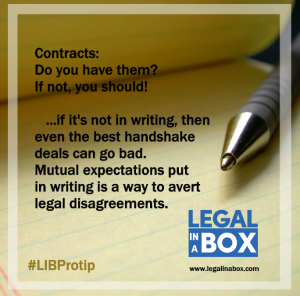Drafting Contracts
Tips To Draft A Clear Contract
The best way to preserve a good business relationship is to memorialize your agreements in writing. This applies to a variety of contracts including lease agreements, employment contracts, co-founder agreements, partnership contracts, licensing agreements etc. Having a clear, concise contract will save you potential future litigation and the hefty fees that go with it.
Be sure to consult your legal advisor and have contracts reviewed from a legal perspective. AMT Law, LLC has a great service that provides free document reviews with a subscription. When you are drafting contracts consistently for your business, try a legal service plan to save time and money. https://www.amtlawgroup.com/subscriptions/
Define
- If you have a sample or similar contract used in the past, that’s a good starting point.
- Outline the specifics of the deal – what are the terms of the agreement?
- Define “what if” scenarios to define and scope out the possible outcomes
 and iron out everyone’s expectations in those scenarios.
and iron out everyone’s expectations in those scenarios. - Start with an existing form to save time – it provides a structure and foundation.
- Get legal forms online – here’s a library of forms available to subscribe to: https://www.legalinabox.com/form-listing/
- When completing a Letter of Intent – be sure it’s clear that it’s NOT a contract by including language such as “This is a non-binding letter of intent which outlines provisions under consideration for a potential contract; this is not a contract and not a legally binding document; this outlines possible contract terms for discussion purposes only.”
Draft
- State legal names of parties to contract in first paragraph – a breach of contract judgment is relevant only for party whose name exactly matches. For individuals, use their name as it appears on driver’s license or state ID with middle name and/or initials. For entities, check state’s database for how company name is registered.
- Identify nicknames in first paragraph – i.e. Widgets R Us, Inc., “Widgets”. This makes the contract easier to read.
- Use only legal terms for nicknames – i.e. don’t use “Agent” unless the party is intended to be an agent – and clarify the scope of their authority if they are an “agent”. “Contractor” would only be used for a legal contractor.
- Include the date in the first paragraph – provides precise description i.e. 10/1/2022 Employment Contract.
- Include the “whereas” clauses or recitals, providing background on the contract. The first paragraph in the body should incorporate these by reference and state they are true and correct. This avoids arguments as to whether recitals are part of contract later.
- List paragraph headings and place in logical order. Paragraphs should follow in same order, often based on importance, custom or chronology. Group related concepts in same paragraph or adjacent ones.
- Write all contract terms related to a paragraph in simple terms – this is what you do or do not agree to, paragraph by paragraph.
- Keep notes as you work, writing down other clauses that come to mind so you can go back and add them.
- Ambiguity is created by repetition – only repeat when necessary for difficult concepts or formulas – be sure that all possible meanings are considered and that examples are consistent with the concept wording.
Clarify Writing
- Include “Contract” in the title to reaffirm this is, in fact, a contract. Titling it with contract clearly states the intention of the document.
- Use short, concise sentences – simplicity is easier to understand.
- Use active tense – “sellers shall sell the property to the buyer” vs. “the property shall be sold to the buyer by the seller”.
- Avoid abbreviation – for example “biweekly” means twice a week or every other week. Instead use exact description.
- Instead of “lessor” and “lessee” use “landlord” and “tenant” because lessor and lessee are easily confused. The same applies to “lienor and “lienee”, “mortgagor” and “mortgagee” so the word cannot be reversed or mistyped.
- Be careful using “herein” – does “wherever used herein” refer to anywhere in contract or in paragraph or sentence?
- Write numbers as words and numerals – (5) five. This reduces chance for errors and makes numbers stand out.
- Clarify intent – when you use “including” add “but not limited to” unless you intend the list to be all-inclusive.
- Write being clear and unambiguous – using rules of grammar are not universal as a judge or jury may have learned different rules. To test for clarity, remove all commas and periods, then read – using proper words in right order will be clear regardless of punctuation.
- Be consistent in use of grammar – pay attention to where you place ending quote marks, whether you use commas after years and states, whether you capitalize dollar amounts etc.
- Avoid creative writing – contract writing should be clear, direct and precise, using common words and meanings.
- Be consistent with your terms – if you refer to “goods”, use it throughout contract, do not go back and forth between “goods” and “items”.
- Consider using choice of law, venue selection and attorneys’ fees clauses. If the contract is litigated, this clarifies for court.
Write for Judge and Jury
- Assume reader is knowledgeable average person – with clear writing the average person will understand and it’s less likely to go to court.
- Define words by capitalizing and placing in quotes – this shows intention of word to have special meaning.
“Wherever used in this contract, “Goods” means the items of tangible property listed in Exhibit “A” and incorporated herein by reference.”
OR
“Buyer hereby agrees to purchase from Seller ten (10) frying pans (“Goods”).”
- Define terms when first used versus a separate section of definitions, making for easier reading.
- Explain technical terms and concepts within the contract itself. Though parties may understand them, judge and jury who read contract may not.
Keep Parties Informed
- Every contract should include a cover letter to include instructions on how parties are to use and sign contract.
- Parties should share ideas as contract is being drafted; things that could go wrong or might happen in future, ways to structure better or possible clauses.
- Write down inherent risks and rewards of contract to share with all parties; problems may become apparent once time is spent trying to word the contract.
Actions After First Draft Written
- Check for errors; spelling, numbering and cross references – review manually as spell check programs misinterpret some legal language.
 Have a second set of eyes review for errors, inconsistencies and confusing areas.
Have a second set of eyes review for errors, inconsistencies and confusing areas.- Include the draft number and date in top margin and document name to keep track of versions.
- Have all parties read draft to assure it’s in tune with everyone’s expectations.
- Compare current and prior versions using Word’s track changes on. This version can be saved as “Redline” version for all parties to see what changes are made as the document progresses.
Print and Sign Final Version
- If using a printed version for signing, print all pages on same paper and reprint entire document if changes are made to assure that no pages are substituted or missed after changes.
- Sign document using blue ink to ease differentiation between signed original and copies.
- Initial every page of contract to confirm all parties have agreed to all pages.
- If signing using an electronic platform such as DocuSign, be sure to keep a record of both the Word document and the PDF uploaded. When fully signed, be sure to download the final PDF and the certificate of signing provided by electronic platform. Keep a screenshot of history of document from signing platform just in case the platform is no longer in use should someone question the validity of the contract execution.
- Identify the parties and witnesses who sign by providing blank lines below their signature for printed name and address. This makes is easier to find witnesses if contract is contested. Remember to use two witnesses when required by your state’s laws.
- Be sure persons signing for entities include their titles, the entity name and the words “by” and “as its”. Failure to do so may result in personal liability for the signer(s). The proper way to sign in a representative capacity is as follows:
Widgets For Us Inc., An Illinois corporation
By: _______________________________
Sam Smith, as its President
- Add a notary clause that complies with state notary law.


